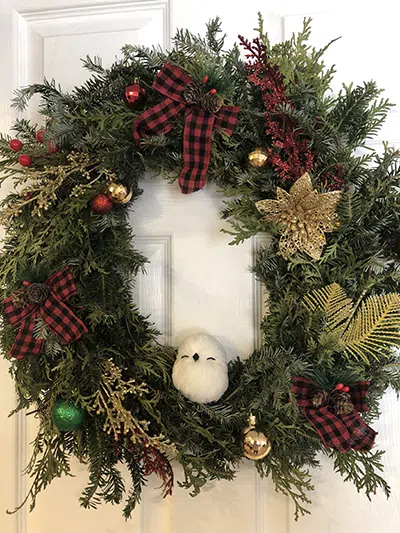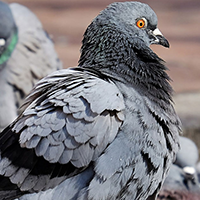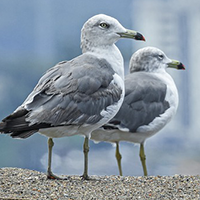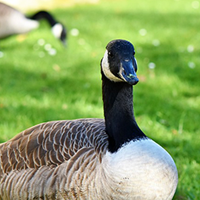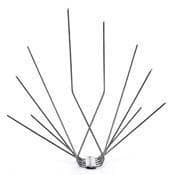Bird spikes is a bird deterrent and ledge protection to prevent roosting and nesting of birds such as Pigeons and Gulls on ledges of buildings. Birds nesting or roosting on the ledges of buildings leads to deterioration and rot of the building facade due to the high acidic content of bird excrement.
Spike Needles, Bird-Flite, Nixalite, Porcupine Needles, Sharp Needles
Bird spikes come in several different sizes, densities and materials. Premium bird spikes are stainless steel with a base suitable for installation with screws or the use of glue. Also available are spikes made of aluminum or plastic; while they may be less expensive, they don’t last as long. Your choice will depend on the bird species and the area for installation.
Hawkeye Bird & Animal Control generally recommends medium to premium bird spikes and permanent bonding solutions for all ledges.The density of bird spikes per foot can be an indication of the quality of product being used. 120 spikes per foot is much better than the cheaper 20 spikes per foot and is tremendously more efficient at deterring birds. The medium to premium bird spikes can be sharp or blunt. Generally, if people will have to work in areas around them, you'd want the blunt ends to prevent injuries.
Bird spikes carry a warranty of up to 20 years. They come in 2 to 4 foot sections and have different profiles depending on where you want to put them - on a wall, ledge, angle or corner.
The plastic bird spikes are U.V. stabilized polycarbonate and mostly used for pigeons and seagulls. Plastic bird spikes won’t work well with other species. The plastic polycarbonate doesn’t interfere with electrical signals and are non conductive. They are very easy to install as they can be glued on or even put on with zip ties or wire ties if used around pipes. There are a great choice for parking garages.
This type of ledge protection is installed on thousands of buildings with high success rates, even under heavy bird pressure. Its thin, stainless steel rods and U.V.-resistant polycarbonate base or stainless base, are extremely durable and it is also quite inconspicuous. Spikes come in several widths; the correct width must be chosen for the right ledge. Not installing a sufficient amount of spikes is a common mistake; the entire ledge needs to be covered to be effective (otherwise pigeons will get in behind it). Also, corners and all open sides of ledge need to be covered and/or closed off.
Product Overview
Where to use:
Ledges, parapets, signs, beams, pipes, chimneys, cutouts, security cameras, lights, etc.
Target Bird:
Pigeon or larger
Bird Pressure:
Medium-Heavy
Material:
Stainless steel and/or polycarbonate.
Installation:
Base is glued or screwed to any surface
Ease of Installation:
Easy
All stainless steel spike sample
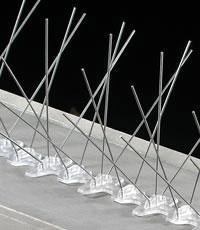
Advantages:
Easy to put up and works reasonably well
Disadvantages:
- The sharp tips can be hazardous for workmen.
- If installed, especially in the lower areas of a building, it my be unattractive (giving the structure a jail-like appearance).
- Some of the polycarbonates crack in the coolest of weather.
- The spikes may be covered in snow and rendered useless.
- Some birds are smart enough to use the spike needles to hold their nesting materials.
- Fall leaves may get caught in the spike needles, providing a base for nesting for the birds.
- Leaving a greater than 2" gap behind the base provides more of an area for the pigeon to get into from the side and walk in and plant the nest from behind. The entire area must be covered which is rather costly.
2.5" Wide - For ledges 2.5" to 4" wide.
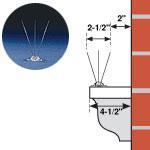
4.5" Wide - For ledges 5" to 7" wide.
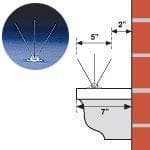
8" Wide - For ledges 7" to 10" wide.
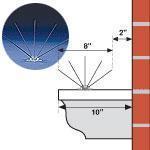
Gutter Point
Rain gutters have always been a problem bird area. For years installers have adapted other bird deterrents for the task. We have simplified the installation, thanks to the introduction of Gutter-Point. Thin stainless steel spikes protrude upwards from a plastic base, making it difficult for
birds to gain a foothold. Gutter-Point's specially designed clips make it easy to install and the spike configuration protects not only the edge of the gutter, but the inside as well.









